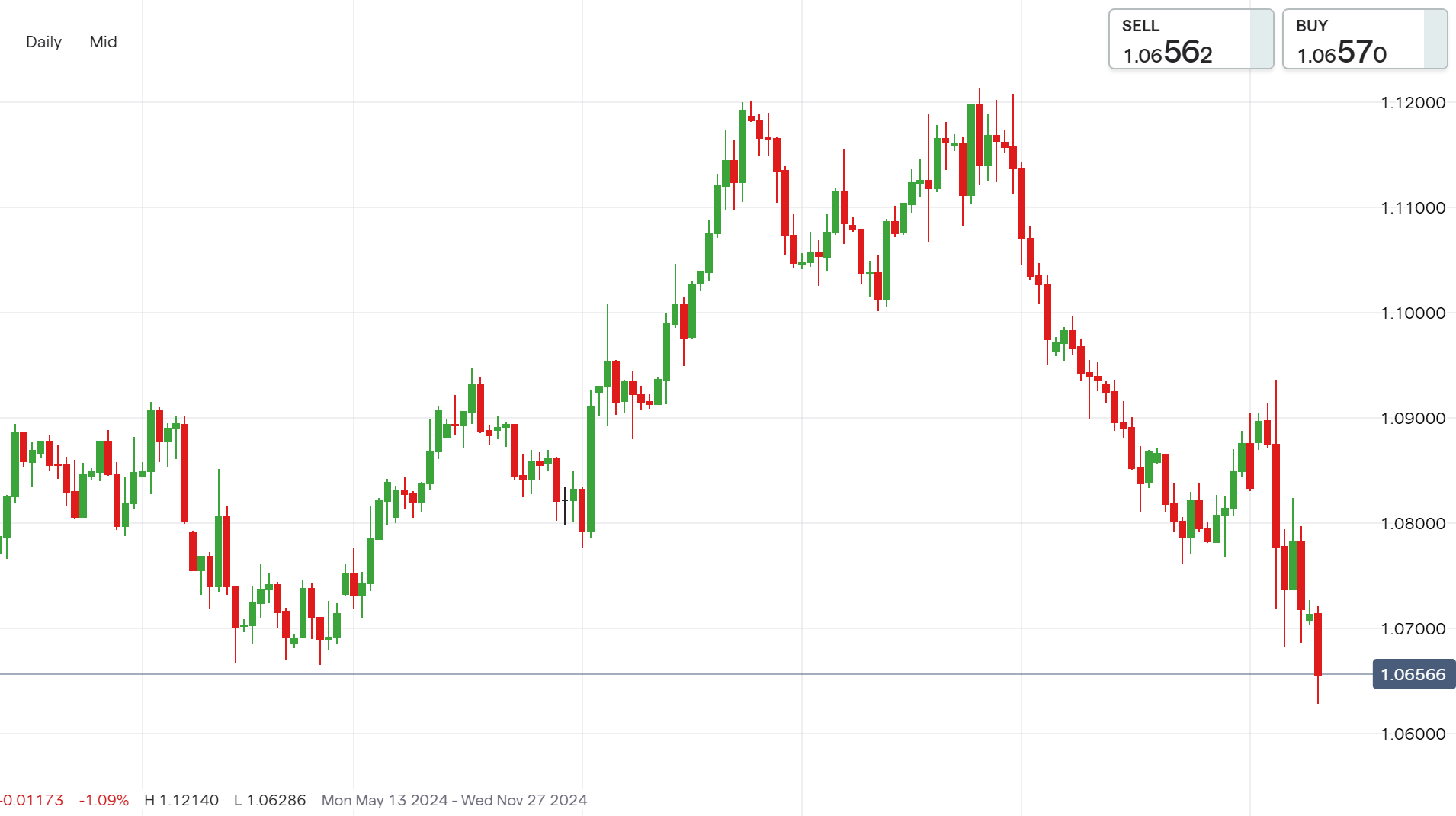EUR/USD continues bearish trend post-election as dollar strength prevails
The EUR/USD hits a six-month low amid ECB rate cut expectations, a strong US dollar post-election, and Eurozone economic challenges. Monitor for policy shifts impacting future currency movements.

Key points
- EUR/USD falls to 1.0655, lowest since late June
- ECB expected to cut rates by 25 bps in December
- USD strengthened by Trump's election and tariff policies
- Eurozone growth concerns weigh on euro's stability
- Traders watch for fiscal policy shifts affecting EUR/USD
EUR/USD Sinks to Lowest Level in Over 6 Months
The euro has fallen below $1.07 per USD, reaching 1.0655, its lowest point since late June. This decline reflects traders' focus on economic, monetary, and political factors impacting the currency. Expectations that the European Central Bank (ECB) might reduce interest rates more aggressively than the US Federal Reserve are exerting downward pressure on the euro. Meanwhile, the US dollar is strengthening due to forecasts that Donald Trump’s policies could increase inflation, potentially restricting the Fed’s capacity to further lower borrowing costs. The ECB is projected to implement a 25 basis point rate cut in December, with market forecasts predicting a reduction to 2% by June.
EUR/USD price history

USD Continues Bullish Trend Post-Election
The dollar index has climbed to around 105.5, reflecting significant gains following last week’s Trump election victory. Trump's policies, which focus heavily on trade tariffs, have strengthened the dollar against most currencies. However, the potential outcome of congressional control is crucial, as it could lead to major fiscal policy shifts regarding spending and taxes. The Federal Reserve announced a cautious 25 basis point rate cut on Thursday; balancing inflation concerns with a weakening labor market. Another similar rate cut is anticipated in December, which could weaken the dollar as political and fiscal uncertainties, combined with expected interest rate cuts, may reduce its appeal to investors seeking stable returns.
Eurozone Economic Turmoil Plays Major Role in Euro Weakness
ECB Vice President Luis de Guindos has expressed concerns that Eurozone growth may be weaker than expected, with global trade barriers posing significant threats to the economy. The local economy has shown minimal growth over the past year, and a Trump presidency could amplify these issues. Recent macroeconomic data supports this pessimistic outlook; the Hamburg Commercial Bank (HCOB) revised the EU Composite Purchasing Managers Index (PMI) to 50.0 for October, indicating stagnant private sector output. Economic activity in Germany and France, the largest Eurozone economies, is shrinking, counteracting growth seen in other areas. If growth remains stagnant or declines, investor confidence in the Eurozone could weaken, putting additional downward pressure on the euro.
What’s Next for EUR/USD?
The EUR/USD pair, at its lowest level in over six months at 1.0655, is facing several challenges that could shape its near-term trajectory. The euro is under pressure from the ECB's potential to cut interest rates more aggressively than the Fed, while the US dollar is gaining strength from Trump's election victory and inflationary policies. The anticipated ECB rate cuts suggest continued euro weakness, as lower rates make the currency less attractive. Meanwhile, the US dollar's bullish momentum, driven by trade tariff policies and a strong dollar index, faces uncertainties. Potential fiscal policy shifts and Fed rate cuts could introduce volatility, with lower US interest rates potentially weakening the dollar's appeal. Traders should monitor these developments to navigate potential fluctuations in the EUR/USD pair effectively.
How to Trade EUR/USD
- Open an account to get started, or practice on a demo account
- Choose your forex trading platform
- Open, monitor, and close positions on EUR/USD
Trading forex requires an account with a forex provider like tastyfx. Many traders also watch major forex pairs like EUR/USD and USD/JPY for potential opportunities based on economic events such as inflation releases or interest rate decisions. Economic events can produce more volatility for forex pairs, which can mean greater potential profits and losses as risks can increase at these times.
You can help develop your forex trading strategies using resources like tastyfx’s YouTube channel. Our curated playlists can help you stay up to date on current markets and understanding key terms. Once your strategy is developed, you can follow the above steps to opening an account and getting started trading forex.
Your profit or loss is calculated according to your full position size. Leverage will magnify both your profits and losses. It’s important to manage your risks carefully as losses can exceed your deposit. Ensure you understand the risks and benefits associated with trading leveraged products before you start trading with them. Trade using money you’re comfortable losing. Past performance is not indicative of future results.
